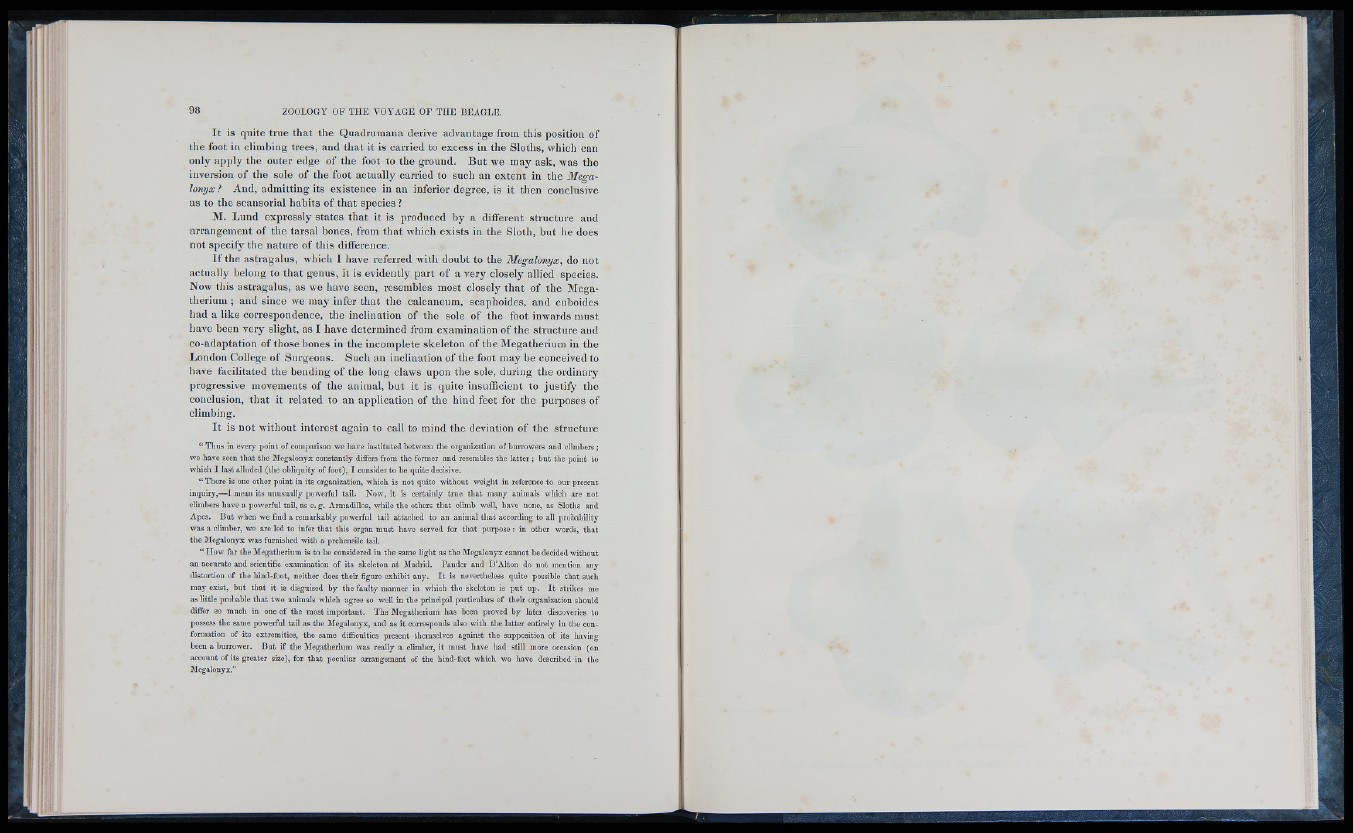
It is quite true that the Quadrumana derive advantage from this position o f
the foot in climbing trees, and that it is carried to ex c e ss in the Sloths, which can
only apply the outer edge o f the foot to the ground. But we may ask, was the
inversion o f the sole o f the foot actually carried to such an ex tent in the 3Iega-
lonyx? And, admitting its existenc e in an inferior degree, is it then conclusive
as to the scansorial habits o f that species ?
M. Lund expressly states that it is produced by a different structure and
arrangement o f the tarsal bones, from that which e x ists in the Sloth, but he does
not spe cify the nature o f this difference.
I f the astragalus, which I have referred with doubt to the Megalonyx, do not
actually belong to that genus, it is evidently part o f a very closely allied species.
Now this astragalus, as we have seen, resembles most closely that o f the Megatherium
; and since we may infer that the calcaneum, scaphoides, and cuboides
had a like correspondence, the inclination o f the sole o f the foot inwards must
have been very slight, as I have determined from examination of the structure and
co-adaptation o f those bones in the incomplete skeleton o f the Megatherium in the
London College o f Surgeons. Such an inclination o f the foot may be conceived to
have facilitated the bending o f the long claws upon the sole, during the ordinary
progressive movements of the animal, but it is quite insufficient to ju stify the
conclusion, that it related to an application o f the hind feet for the purposes o f
climbing.
It is not without interest again to call to mind the deviation o f the structure
“ Thus in every point of comparison we have instituted between the organization of butrowers and climbers ;
we have seen that the flicgalonyx constantly differs from the former and resembles the la tte r; but the point to
which I last alluded (the obliquity of foot), I consider to be quite decisive.
“ There is one other point in its organization, which is not quite without weight in reference to our present
inquiry,—I mean its unusually powerful tail. Now, it is certainly true that many animals which are not
climbers have a powerful tail, as e. g. Armadillos, while the others that climb well, have none, as Sloths and
Apes. But when we find a remarkably powerful tail attached to an animal th a t according to all probability
was a climber, we are led to infer that this organ must have served for that purpose : in other words, that
the Megalonyx was furnished with a prehensile tail.
“ How far the Megatherium is to be considered in the same light as the Megalonyx cannot be decided without
an accurate and scientific examination of its skeleton at Madrid. Pander and D’Alton do not mention any
distortion of the hind-foot, neither does their figure exhibit any. I t is nevertheless quite possible that such
may exist, but that it is disguised by the faulty manner in which the skeleton is put up. I t strikes me
as little probable that two animals which agree so well in the principal particulars of their organization should
differ so much in one of the most important. The Megatherium has been proved by later discoveries to
possess the same powerful tail as the Megalonyx, and as it corresponds also with the latter entirely in the conformation
of its extremities, the same difficulties present themselves against the supposition of its having
been a burrower. But if the Megatherium was really a climber, it must have had still more occasion (on
account of its greater size), for that peculiar arrangement of the hind-fcet which we have described in the
Megalonyx.”